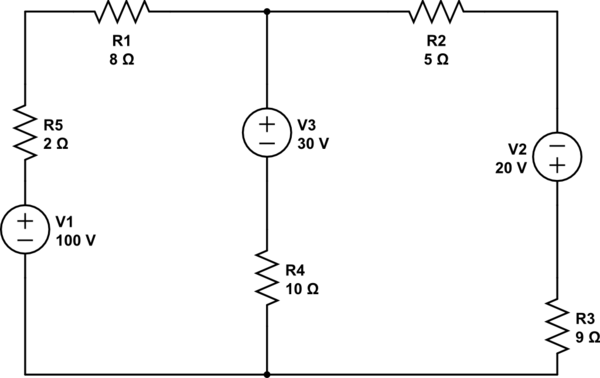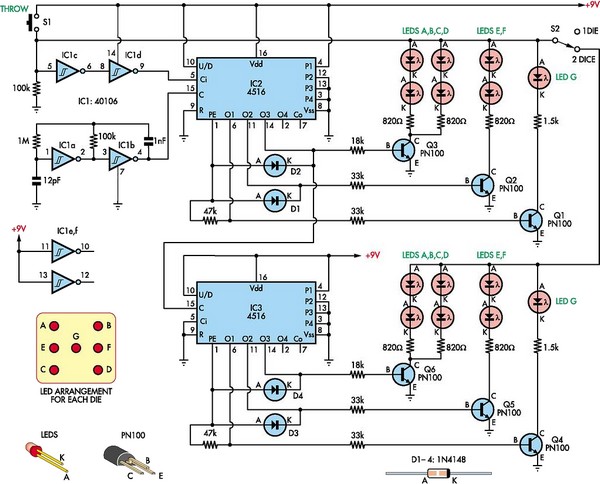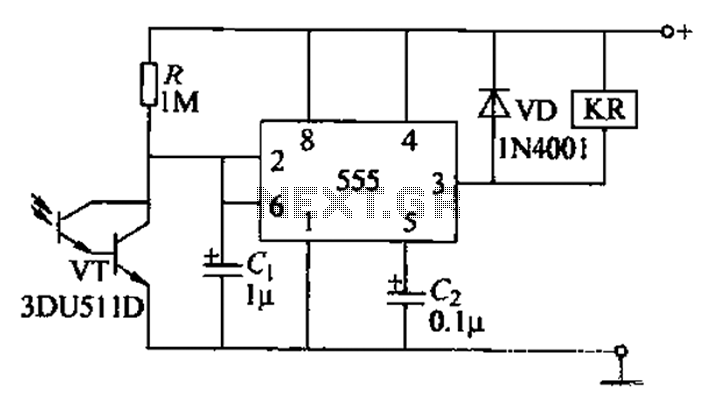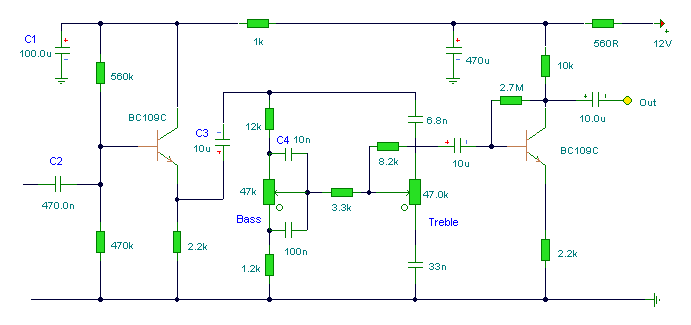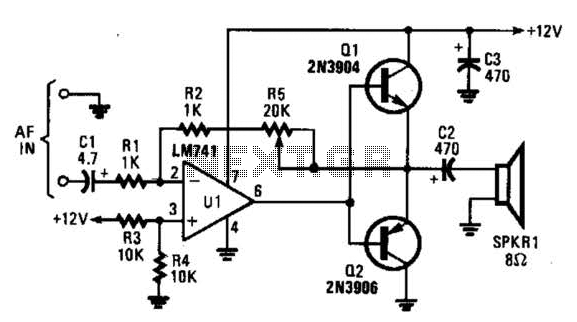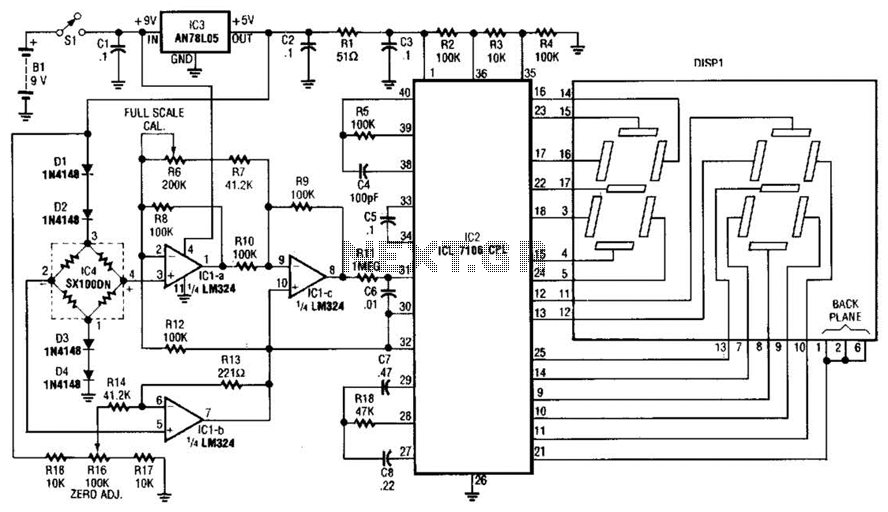
whistle responder schematic circuit diagram
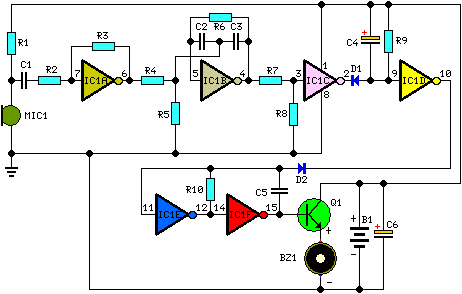
This device emits intermittent beeping for approximately two seconds when a whistle is detected from a person within a range of around 10 meters. The first two inverters in IC1 function as audio amplifiers. IC1A amplifies the signal captured by a small electret microphone, while IC1B serves as a band-pass filter, centered at about 1.8 kHz. This filter is essential for isolating the specific frequency of the whistle, thereby preventing activation from other frequencies that could lead to unwanted beeping. IC1C is configured as a Schmitt trigger, which squares the incoming audio signal. IC1D is a monostable circuit providing a two-second delay, which drives the astable configuration formed by IC1E and IC1F. This oscillator produces a square wave at a frequency of 3 to 5 Hz, which is used to drive Q1 and BZ1, resulting in the intermittent beeping operation.
The circuit operates primarily through the integration of several key components. The electret microphone converts sound waves into an electrical signal, which is then amplified by IC1A. The amplification ensures that even faint sounds, such as a whistle, can be detected effectively. Following amplification, IC1B filters the signal to allow only the desired frequency range to pass, which is critical in environments with background noise. The use of a band-pass filter ensures that the device remains sensitive to the specific frequency of the whistle while ignoring other sounds that may trigger false positives.
The output from the band-pass filter is fed into IC1C, which acts as a Schmitt trigger. This component is crucial for converting the analog audio signal into a clean digital signal, effectively eliminating noise and ensuring that the subsequent stages of the circuit receive a stable input. The square wave output from the Schmitt trigger is then processed by IC1D, which is configured as a monostable timer. This timer introduces a two-second delay, which allows the circuit to remain inactive for a brief period after detecting a whistle, thereby preventing rapid successive triggering.
The output from IC1D is connected to the astable multivibrator formed by IC1E and IC1F. This configuration generates a square wave oscillation at a frequency between 3 to 5 Hz, which is suitable for driving the transistor Q1. The transistor acts as a switch, controlling the power to the buzzer BZ1. When activated, BZ1 produces the intermittent beeping sound, alerting users to the presence of a whistle within the detection range.
Overall, this circuit design is effective for applications requiring sound detection and alerting, such as security systems or personal safety devices. Its ability to filter out unwanted noise while selectively responding to specific sound frequencies enhances its reliability and functionality in real-world scenarios.This device beeps intermittently for about two seconds when a person in a range of around 10 meters emits a whistle. The first two inverters contained in IC1 are used as audio amplifiers. IC1A amplifies consistently the signal picked-up by the small electret-microphone and IC1B acts as a band-pass filter, its frequency being centered at about 1.8KHz.
The filter is required in order to select a specific frequency, the whistle`s one, stopping other frequencies that would cause undesired beeper operation. IC1C is wired as a Schmitt trigger, squaring the incoming audio signal. IC1D is a 2 second-delay monostable driving the astable formed by IC1E & IC1F. This oscillator generates a 3 to 5Hz square wave feeding Q1 and BZ1, thus providing intermittent beeper operation..
🔗 External reference
The circuit operates primarily through the integration of several key components. The electret microphone converts sound waves into an electrical signal, which is then amplified by IC1A. The amplification ensures that even faint sounds, such as a whistle, can be detected effectively. Following amplification, IC1B filters the signal to allow only the desired frequency range to pass, which is critical in environments with background noise. The use of a band-pass filter ensures that the device remains sensitive to the specific frequency of the whistle while ignoring other sounds that may trigger false positives.
The output from the band-pass filter is fed into IC1C, which acts as a Schmitt trigger. This component is crucial for converting the analog audio signal into a clean digital signal, effectively eliminating noise and ensuring that the subsequent stages of the circuit receive a stable input. The square wave output from the Schmitt trigger is then processed by IC1D, which is configured as a monostable timer. This timer introduces a two-second delay, which allows the circuit to remain inactive for a brief period after detecting a whistle, thereby preventing rapid successive triggering.
The output from IC1D is connected to the astable multivibrator formed by IC1E and IC1F. This configuration generates a square wave oscillation at a frequency between 3 to 5 Hz, which is suitable for driving the transistor Q1. The transistor acts as a switch, controlling the power to the buzzer BZ1. When activated, BZ1 produces the intermittent beeping sound, alerting users to the presence of a whistle within the detection range.
Overall, this circuit design is effective for applications requiring sound detection and alerting, such as security systems or personal safety devices. Its ability to filter out unwanted noise while selectively responding to specific sound frequencies enhances its reliability and functionality in real-world scenarios.This device beeps intermittently for about two seconds when a person in a range of around 10 meters emits a whistle. The first two inverters contained in IC1 are used as audio amplifiers. IC1A amplifies consistently the signal picked-up by the small electret-microphone and IC1B acts as a band-pass filter, its frequency being centered at about 1.8KHz.
The filter is required in order to select a specific frequency, the whistle`s one, stopping other frequencies that would cause undesired beeper operation. IC1C is wired as a Schmitt trigger, squaring the incoming audio signal. IC1D is a 2 second-delay monostable driving the astable formed by IC1E & IC1F. This oscillator generates a 3 to 5Hz square wave feeding Q1 and BZ1, thus providing intermittent beeper operation..
🔗 External reference
